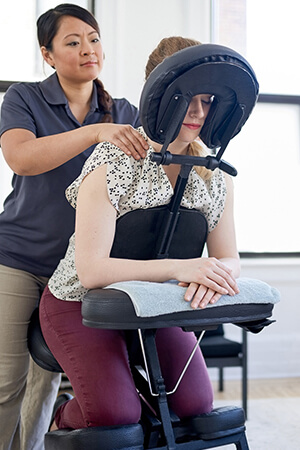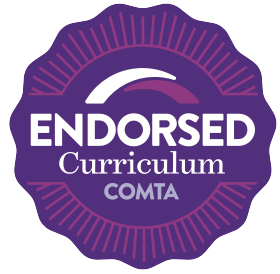In This Article
- Becoming a Massage Therapist
- Massage Therapy Schooling
- Online Programs
- Massage School Accreditation
- School Tuition
- State Boards of Massage
- Types of Massage
- Massage Therapist Duties
- Massage Therapist Salary
Massage Therapy Schools and Education Programs

It’s an exciting time to get an education in massage therapy. The opportunities for massage therapists have rapidly expanded, with jobs available in a wide variety of settings, including resorts and spas, fitness centers, stretching clinics, medical clinics, and private practice.
What’s more, the education requirements needed to become a massage therapist are fairly straightforward and can often be completed in a matter of months, not years.
The field and scope of medical massage is expanding as well. “In the last decade, massage therapy has gained traction as a legitimate adjunct to traditional medical services, and, sometimes, is an effective alternative to problems such as pain management,” says Lisa McNeil, M. Ed, CFSS-M, a Wisconsin-based licensed massage therapist who has also worked with professional and Olympic athletes. “With the right massage therapy school and training, one can position oneself as a medical provider and build a reputation in the medical community.”
These developments have opened up a number of interesting, specialized areas of study for prospective massage students through a variety of educational programs.
Massage Therapist Schooling and Timelines
What Degree Do You Need to Be a Massage Therapist?
An education in massage therapy is very different than the education you’d need to earn an associate or bachelor’s degree—and it allows you to start your career more quickly.
Massage therapy programs are offered in a range of settings, including career training schools, public institutions such as community colleges, nonprofit programs, single-owner private schools, and “chain” schools with multiple campuses.
How Long Is Massage Therapy School?
These programs vary widely but typically offer a diploma or certificate—essentially a technical degree—in massage therapy, any of which usually takes about six months to a year or longer to complete, depending on how much advanced training is included and whether you attend on a full-time or part-time basis. Some community colleges also offer a two-year associate’s degree along with massage therapy training.

One type of credential isn’t necessarily more desirable than another. One of the most important considerations to keep in mind when choosing a massage school is the type of work you ultimately want to do, and the licensing regulations in your state.
Every state has different laws regarding the practice of massage therapy, but most require professionals in the field to hold a license of some sort. Your state might require you to complete a certain number of hours of education (usually ranging from 500–1,000 hours) and pass a national exam like the Massage & Bodywork Licensing Examination (MBLEx), for example.
Look up the regulations in your state to understand what requirements you need to meet to practice as a massage therapist, and make sure the program you choose will prepare you to meet these criteria.
What Will I Study in Massage School?
Massage therapy classes may vary according to state regulations, but in most cases, students will start by learning anatomy, physiology, kinesiology, and contraindications to massage (conditions or symptoms that make massage therapy inadvisable).
The coursework can be rigorous. Students learn 2,500 anatomical terms and massage concepts that they need to be able to define in their own words on a national licensing exam. “Many of these terms are in Latin, and it can feel like you are learning a whole new language,” says Lewis.
Programs typically offer a special diploma or certificate in massage therapy, which take about six months to a year to complete.
In addition to these science classes, students learn classic techniques such as Swedish massage and deep tissue work. Students might also learn about hygiene, professionalism, career development, communication skills, and marketing strategies, which is especially helpful as you’ll be building your personal “brand,” whether you work for someone else or work in private practice.
Most schools for massage therapy also have a hands-on clinic where students can practice their knowledge and skills on the public and get graded feedback. As part of their massage therapy courses or through continuing education classes, students may also gain specialized training in different areas such as sports massage, myofascial release therapy, prenatal massage, reflexology, infant massage, and many other areas.
Massage Therapy Continuing Education & Specialty Certificates

As you think about where to attend massage school, you might wonder if you need a specific type of education if you want to work as a massage therapist in a spa versus a medical clinic. “Not necessarily,” Lewis explains. “The core principles of massage apply in every setting.”
You can build on your massage skills with additional training or continuing education focused on a specific topic area if you like. According to Lewis, “if you’re working in a spa, you might need to learn how to do additional services beyond massage, such as wraps, scrubs, and aromatherapy. Whereas in a chiropractic office, you might want more advanced treatment training in deep tissue massage to help people recovering from injuries.”
To set yourself up to be a more attractive job candidate in the medical massage field, for example, McNeil recommends making sure your educational program—especially any continuing education or certification you take on—focuses heavily on anatomy and physiology. “The program should have a significant number of hours dedicated to the palpation, knowledge, and understanding of what comprises connective tissue, how it functions and where it is located,” she says.
Continuing education classes are a common way that massage therapists specialize their careers and develop advanced skills to better serve specific populations of people or work in more niche settings.
Specialty certificates are available from the National Certification Board for Therapeutic Massage & Bodywork (NCBTMB) in these areas:
Massage therapists can also choose to become board certified in massage therapy, which is the highest voluntary credential available to massage therapists.
Can You Really Take Massage Classes Online?
Because of the nature of the profession, massage therapy education centers on hands-on learning. Online courses are usually only available to a limited extent in this field.
Some massage therapy schools do incorporate online classes into their entry-level programs and continuing education coursework. “There aren’t that many schools offering more than 50% of their courses online, but there are some,” according to Lewis.
When considering online courses as part of your massage education, ask the school for details about the format. Will you be able to communicate with instructors and other students easily? Are the courses self-paced, or do you need to log in at specific times? Do the online courses offer you the same curriculum and training that you would receive in an on-campus setting?
In addition, consider whether you need the structure and accountability of an in-person class, or whether you’d benefit from the flexibility to attend class at home.
How Much Does Massage Therapy School Cost?

Tuition for massage school costs vary widely program to program, from $5,000 to up to $20,000, according to Lewis. More expensive programs may offer more depth and breadth, giving you a chance to learn a wider array of techniques over a longer period of time, while less expensive programs may focus on a narrower range of coursework.
Where the program is located can also be a factor in the cost. In addition, higher cost programs often offer financial aid.
Beyond the cost of tuition, you may need to pay for a massage table (though some programs include this in their fees) and purchase textbooks and additional supplies.
Some scholarships are available for massage therapy students. For example, the ABMP offers its student members a chance to receive a $1,000 scholarship each month, and some massage therapy schools offer their own scholarship opportunities as well.
For more information about the cost of massage therapy school, visit our page on tuition and financial aid.
What to Look for in a Massage School
When considering a massage school, do your homework by looking at the school’s website and reading any reviews. Find out if financial aid is available. Schools that offer financial aid are required to post exam pass rates for students and other information that might help you assess the quality of the program. Take the time to review this information.

Another great tip: “Visit the school and take a tour,” Lewis suggests. “When you see the environment for yourself, you can pick up on whether it’ll be a great fit for you. Learn what the student success stories are. See how happy the students look and what the buzz feels like on campus. Get a sense for the curriculum and compare it to the direction you want to go in. For example, if you’re interested in prenatal massage, do they even have a class on that?”
Find out how long the massage program has been in existence and what its graduate success rates are.
When you look at the curriculum, see whether it gives you a taste for different types of massage. Learning about different specialties can help you figure out what you might like to focus on in the future, whether that’s infant massage or reflexology.
If you need to take the MBLEx to become licensed in your state, find out if there’s a prep course at the school, or if the school provides study groups.
Ask what the hands-on training in the clinic is like so you know what to expect. How many sessions will you need to complete? It’s also helpful to ask about the faculty’s experience and tenure at the school. It may be a red flag if there has been a lot of recent staff turnover. Find out if the faculty continue to practice massage part-time in addition to their teaching. Having your instructor share their personal experiences in the field can be immensely valuable.
Massage Therapy School Accreditation
Accreditation is another factor to keep in mind when evaluating a massage school. Accreditation is a voluntary review process that helps ensure that a school or program meets certain quality standards set by an outside agency.
One key benefit of accredited massage therapy schools is their eligibility for federal financial aid, but some unaccredited schools keep their tuition low enough so that the ability to take out student loans is less critical.
Although accreditation can be valuable, it doesn’t always guarantee that a massage therapy school offers the highest quality education, according to Lewis. In fact, many excellent massage schools have chosen not to pursue accreditation.
Most types of accreditation aren’t specific to massage therapy education and cover a broad range of unrelated programs. However, one type of accreditation that has much more relevance for massage therapy is called the Commission on Massage Therapy Accreditation (COMTA). This type of accreditation is the only specialized accreditor for massage.

As you research programs, accreditation is one metric to consider, but it’s also important to find out how long the massage program has been in existence and what its graduate success rates are.
Admission Requirements
To get into massage school, you usually need a high school diploma or GED. A majority of schools require prospective students to be interviewed as part of the application process, according to the American Massage Therapy Association’s 2019 Massage Profession Research Report. Although less common, some schools also require applicants to provide a written essay.
Career Opportunities and Outlook
The good news for massage students is that many schools offer students active assistance with job placement after graduation. Students might have access to career fairs, interview days with local employers, and job listings through their massage school. Be sure to ask up front how the school can help you find a job once you graduate.
“Joining a massage therapy association is also a great way to keep job opportunities at your fingertips,” says Lewis. “All student members with Associated Bodywork & Massage Professionals receive free graduate support including access to our national job board.”
Becoming a massage therapist in your state
Find comprehensive information about becoming a massage therapist in the top states for the field. Read about required education, exams, licensing and find resources to help you thrive as a massage therapist.
Check out our massage therapist salary page to get an understanding of the income potential for this occupation.
Written and reported by:
Natural Healers Team
With professional insight from:
Lisa McNeil, M. Ed, CFSS-M
Licensed Massage Therapist, Momentum Movement Clinic
